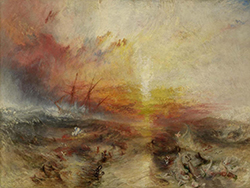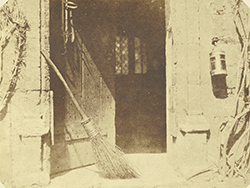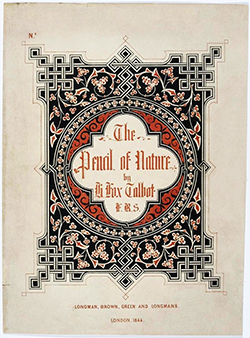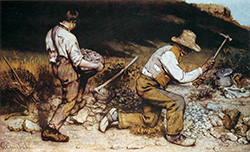MENU
The Electronic Scholarly Publishing Project: Providing access to classic scientific papers and other scholarly materials, since 1993. More About: ESP | OUR CONTENT | THIS WEBSITE | WHAT'S NEW | WHAT'S HOT
Comparative Timelines
The ESP Timeline (one of the site's most popular features) has been completely updated to allow the user to select (using the timeline controls above each column) different topics for the left and right sides of the display.
Select:
New Left Column
New Left Column
Dates
Decade
New Right Column
New Right Column
 Alexandre-Edmond Becquerel shows that light can initiate chemical reactions that produce an electric current.
Alexandre-Edmond Becquerel shows that light can initiate chemical reactions that produce an electric current.
1840
 Anna, the Duchess of Bedford (1788-1861), introduces the ritual of afternoon tea in Britain, although tea has been available in England since the late 1600s.
Anna, the Duchess of Bedford (1788-1861), introduces the ritual of afternoon tea in Britain, although tea has been available in England since the late 1600s.
 The polka makes its U.S. debut, introduced by the ballerina Fanny Elssler (1810-1884), who had brought the dance to Paris in 1834.
The polka makes its U.S. debut, introduced by the ballerina Fanny Elssler (1810-1884), who had brought the dance to Paris in 1834.
 The saxophone is invented in Belgium, by the 26-year old instrument maker Antoine Joseph Sax (1814-1894).
The saxophone is invented in Belgium, by the 26-year old instrument maker Antoine Joseph Sax (1814-1894).
 Painting by J. M. W. Turner: The Slave Ship, originally titled Slavers Throwing overboard the Dead and Dying — Typhon coming on, is a painting by the British artist J. M. W. Turner, first exhibited at The Royal Academy of Arts in 1840. In this classic example of a Romantic maritime painting, Turner depicts a ship visible in the background, sailing through a tumultuous sea of churning water and leaving scattered human forms floating in its wake. Turner was possibly moved to paint The Slave Ship after reading about the slave ship Zong in The History and Abolition of the Slave Trade by Thomas Clarkson the second edition of which was published in 1839. The initial exhibition of the painting in 1840 coincided with international abolitionist campaigns.
Painting by J. M. W. Turner: The Slave Ship, originally titled Slavers Throwing overboard the Dead and Dying — Typhon coming on, is a painting by the British artist J. M. W. Turner, first exhibited at The Royal Academy of Arts in 1840. In this classic example of a Romantic maritime painting, Turner depicts a ship visible in the background, sailing through a tumultuous sea of churning water and leaving scattered human forms floating in its wake. Turner was possibly moved to paint The Slave Ship after reading about the slave ship Zong in The History and Abolition of the Slave Trade by Thomas Clarkson the second edition of which was published in 1839. The initial exhibition of the painting in 1840 coincided with international abolitionist campaigns.
(no entry for this year)
1841
The Berlin Zoo opens, when Friedrich Wilhelm IV, the King of Prussia, donates his pheasant gardens and exotic animal colection to the citizens of Berlin.
The New York State Fair is held for the first time, in Syracuse, New York. The Fair is the first in the tradition of U.S. state fairs with agricultural and domestic themes.
 Self-Reliance, by Ralph Waldo Emerson (1803-1882) [essay II in Essays: First Series] is published.
Self-Reliance, by Ralph Waldo Emerson (1803-1882) [essay II in Essays: First Series] is published.
 The first novel in the series called "Leatherstocking Tales", The Deerslayer, by James Fennimore Cooper (1789-1851), is published
The first novel in the series called "Leatherstocking Tales", The Deerslayer, by James Fennimore Cooper (1789-1851), is published
In London, the periodical Punch begins publication.
 German physician and physicist Julius Robert Mayer is the first to state the law of conservation of energy, noting specifically that heat and mechanical energy are two aspects of the same thing.
German physician and physicist Julius Robert Mayer is the first to state the law of conservation of energy, noting specifically that heat and mechanical energy are two aspects of the same thing.
 On the uniform motion of heat in homogeneous solid bodies, by William Thomson, aka Lord Kelvin (1824-1907), is published. Thomson's concern with the physics of cooling bodies will draw him into debates concerning the age of the Earth. In 1846 he calculates that the Earth can be no more than 100 million years old.
On the uniform motion of heat in homogeneous solid bodies, by William Thomson, aka Lord Kelvin (1824-1907), is published. Thomson's concern with the physics of cooling bodies will draw him into debates concerning the age of the Earth. In 1846 he calculates that the Earth can be no more than 100 million years old.
 The change in the observed frequency of waves emitted from a source, moving relative to the observer, is described by Christian Johann Doppler (1803-1853). This phenomenon is now known as the Doppler Effect.
The change in the observed frequency of waves emitted from a source, moving relative to the observer, is described by Christian Johann Doppler (1803-1853). This phenomenon is now known as the Doppler Effect.
1842
 In May, Edgar Allan Poe's (1809-1849) story "The Masque of the Red Death" appears in Graham's Magazine.
In May, Edgar Allan Poe's (1809-1849) story "The Masque of the Red Death" appears in Graham's Magazine.
 James Prescott Joule determines the mechanical equivalent of heat by measuring the rise in temperature produced in water by stirring it.
James Prescott Joule determines the mechanical equivalent of heat by measuring the rise in temperature produced in water by stirring it.
1843
In London, The Economist and Sunday News of the World begin publication.
 In Dresden, Richard Wagner's opera Der fliegende Holländer is premiered.
In Dresden, Richard Wagner's opera Der fliegende Holländer is premiered.
(no entry for this year)
1844
In England, the Young Men's Christian Association (YMCA) is founded by George Williams (1821-1905).
 The Open Door is an early calotype, included in The Pencil of Nature, the first commercially published book to be illustrated with photographs.
The Open Door is an early calotype, included in The Pencil of Nature, the first commercially published book to be illustrated with photographs.
 The Pencil of Nature, published in six installments between 1844 and 1846, was the "first photographically illustrated book to be commercially published" or "the first commercially published book illustrated with photographs". It was wholly executed by the new art of Photogenic Drawing, without any aid whatever from the artist's pencil and regarded as an important and influential work in the history of photography. Written by William Henry Fox Talbot and published by Longman, Brown, Green & Longmans in London, the book detailed Talbot's development of the calotype process and included 24 calotype prints, each one pasted in by hand, illustrating some of the possible applications of the new technology. Since photography was still very much a novelty and many people remained unfamiliar with the concept, Talbot felt compelled to insert the following notice into his book: The plates of the present work are impressed by the agency of Light alone, without any aid whatever from the artist's pencil. They are the sun-pictures themselves, and not, as some persons have imagined, engravings in imitation.
The Pencil of Nature, published in six installments between 1844 and 1846, was the "first photographically illustrated book to be commercially published" or "the first commercially published book illustrated with photographs". It was wholly executed by the new art of Photogenic Drawing, without any aid whatever from the artist's pencil and regarded as an important and influential work in the history of photography. Written by William Henry Fox Talbot and published by Longman, Brown, Green & Longmans in London, the book detailed Talbot's development of the calotype process and included 24 calotype prints, each one pasted in by hand, illustrating some of the possible applications of the new technology. Since photography was still very much a novelty and many people remained unfamiliar with the concept, Talbot felt compelled to insert the following notice into his book: The plates of the present work are impressed by the agency of Light alone, without any aid whatever from the artist's pencil. They are the sun-pictures themselves, and not, as some persons have imagined, engravings in imitation.
 Michael Faraday relates magnetism to light after finding the magnetic field effects the polarization of light in crystals. He proposes that light may be waves of electromagnetism. He also describes the phenomena of diamagnetism and paramagnetism, which he explains in terms of his concept of a magnetic field.
Michael Faraday relates magnetism to light after finding the magnetic field effects the polarization of light in crystals. He proposes that light may be waves of electromagnetism. He also describes the phenomena of diamagnetism and paramagnetism, which he explains in terms of his concept of a magnetic field.
1845
Scientific American is founded by Alfred Beach (1826-1896). The first issue is published on August 28. The publication, in newspaper format, presents science for the general reader.
 Edgar Allan Poe's "The Raven" appears in the New York Evening Mirror. Poe's collection The Raven and Other Poems is published.
Edgar Allan Poe's "The Raven" appears in the New York Evening Mirror. Poe's collection The Raven and Other Poems is published.
 James Prescott Joule discovers that the length of an iron bar changes slightly when the bar is magnetized.
James Prescott Joule discovers that the length of an iron bar changes slightly when the bar is magnetized.
1846
(no entry for this year)
 Über die Erhaltung der Kraft ("On the Conservation of Force"), by Hermann Ludwig von Helmholtz (1821-1894), is published. It articulates what later becomes known as the Conservation of Energy.
Über die Erhaltung der Kraft ("On the Conservation of Force"), by Hermann Ludwig von Helmholtz (1821-1894), is published. It articulates what later becomes known as the Conservation of Energy.
1847
(no entry for this year)
 An absolute scale of temperatures is proposed by William Thomson (1824-1907). Thomson will become Baron Kelvin of Largs, in 1892, and the scale will come to bear his name.
An absolute scale of temperatures is proposed by William Thomson (1824-1907). Thomson will become Baron Kelvin of Largs, in 1892, and the scale will come to bear his name.
 Armand Hippolyte Louis Fizeau suggests that light from a source of moving away from the observer will be shifted toward the red end of the spectrum, a phenomenon known as redshift. This is closely related to, but not exactly the same as, the Doppler effect.
Armand Hippolyte Louis Fizeau suggests that light from a source of moving away from the observer will be shifted toward the red end of the spectrum, a phenomenon known as redshift. This is closely related to, but not exactly the same as, the Doppler effect.
1848
 Painting by Jean Auguste Dominique Ingres: Venus Anadyomene, now held at the Musée Condé, Chantilly, France. It is a female nude of the Venus Anadyomene type, showing the goddess Venus rising from the sea. Ingres began the painting in 1808 during his stay in Rome at the French Academy. The first preparatory drawings showed Venus in the Venus Pudica position, standing and covering her breasts with her hands. The pose was inspired by Botticelli's The Birth of Venus — Ingres visited Florence and the Uffizi in 1805 and could have seen the painting there. A drawing of 1806 then shows the goddess with her arms in the air and her hair in her hands, a pose the artist also used in his 1856 The Source. The painting remained in the planning stages until 1848, when he completed it as a commission from the banker and botanist Benjamin Delessert.
Painting by Jean Auguste Dominique Ingres: Venus Anadyomene, now held at the Musée Condé, Chantilly, France. It is a female nude of the Venus Anadyomene type, showing the goddess Venus rising from the sea. Ingres began the painting in 1808 during his stay in Rome at the French Academy. The first preparatory drawings showed Venus in the Venus Pudica position, standing and covering her breasts with her hands. The pose was inspired by Botticelli's The Birth of Venus — Ingres visited Florence and the Uffizi in 1805 and could have seen the painting there. A drawing of 1806 then shows the goddess with her arms in the air and her hair in her hands, a pose the artist also used in his 1856 The Source. The painting remained in the planning stages until 1848, when he completed it as a commission from the banker and botanist Benjamin Delessert.
 Armand Hippolyte Louis Fizeau measures the velocity of light in error by measuring the time it takes for a beam of light to pass between the teeth of a rotating gear. The light is reflected by a mirror and stopped by the next tooth of the gear. The result, 315,000 km/se4c (196,000 miles/sec), is within 5% of today's accepted value.
Armand Hippolyte Louis Fizeau measures the velocity of light in error by measuring the time it takes for a beam of light to pass between the teeth of a rotating gear. The light is reflected by a mirror and stopped by the next tooth of the gear. The result, 315,000 km/se4c (196,000 miles/sec), is within 5% of today's accepted value.
 In describing Sadi Carnot's theory of heat, published in 1824, William Thomson (1824-1907) uses the term THERMODYNAMICS.
In describing Sadi Carnot's theory of heat, published in 1824, William Thomson (1824-1907) uses the term THERMODYNAMICS.
 The speed of light is measured by physicist Armand Hippolyte Louis Fizeau (1819-1896) to be approximately 186,000 miles per second.
The speed of light is measured by physicist Armand Hippolyte Louis Fizeau (1819-1896) to be approximately 186,000 miles per second.
1849
 Henry David Thoreau's A week on the Concord and Merrimack Rivers and "Resistance to Civil Government" (often referred to as "Civil Disobedience") are published.
Henry David Thoreau's A week on the Concord and Merrimack Rivers and "Resistance to Civil Government" (often referred to as "Civil Disobedience") are published.
 Painting by Gustave Courbet: The Stone Breakers (French: Les Casseurs de pierres) is a work of social realism, depicting two peasants, a young man and an old man, breaking rocks. The painting was first exhibited at the Paris Salon of 1850. It was destroyed during World War II, along with 154 other pictures, when a transport vehicle moving the pictures to the castle of Königstein, near Dresden, was bombed by Allied forces in February 1945.
Painting by Gustave Courbet: The Stone Breakers (French: Les Casseurs de pierres) is a work of social realism, depicting two peasants, a young man and an old man, breaking rocks. The painting was first exhibited at the Paris Salon of 1850. It was destroyed during World War II, along with 154 other pictures, when a transport vehicle moving the pictures to the castle of Königstein, near Dresden, was bombed by Allied forces in February 1945.
ESP Quick Facts
ESP Origins
In the early 1990's, Robert Robbins was a faculty member at Johns Hopkins, where he directed the informatics core of GDB — the human gene-mapping database of the international human genome project. To share papers with colleagues around the world, he set up a small paper-sharing section on his personal web page. This small project evolved into The Electronic Scholarly Publishing Project.
ESP Support
In 1995, Robbins became the VP/IT of the Fred Hutchinson Cancer Research Center in Seattle, WA. Soon after arriving in Seattle, Robbins secured funding, through the ELSI component of the US Human Genome Project, to create the original ESP.ORG web site, with the formal goal of providing free, world-wide access to the literature of classical genetics.
ESP Rationale
Although the methods of molecular biology can seem almost magical to the uninitiated, the original techniques of classical genetics are readily appreciated by one and all: cross individuals that differ in some inherited trait, collect all of the progeny, score their attributes, and propose mechanisms to explain the patterns of inheritance observed.
ESP Goal
In reading the early works of classical genetics, one is drawn, almost inexorably, into ever more complex models, until molecular explanations begin to seem both necessary and natural. At that point, the tools for understanding genome research are at hand. Assisting readers reach this point was the original goal of The Electronic Scholarly Publishing Project.
ESP Usage
Usage of the site grew rapidly and has remained high. Faculty began to use the site for their assigned readings. Other on-line publishers, ranging from The New York Times to Nature referenced ESP materials in their own publications. Nobel laureates (e.g., Joshua Lederberg) regularly used the site and even wrote to suggest changes and improvements.
ESP Content
When the site began, no journals were making their early content available in digital format. As a result, ESP was obliged to digitize classic literature before it could be made available. For many important papers — such as Mendel's original paper or the first genetic map — ESP had to produce entirely new typeset versions of the works, if they were to be available in a high-quality format.
ESP Help
Early support from the DOE component of the Human Genome Project was critically important for getting the ESP project on a firm foundation. Since that funding ended (nearly 20 years ago), the project has been operated as a purely volunteer effort. Anyone wishing to assist in these efforts should send an email to Robbins.
ESP Plans
With the development of methods for adding typeset side notes to PDF files, the ESP project now plans to add annotated versions of some classical papers to its holdings. We also plan to add new reference and pedagogical material. We have already started providing regularly updated, comprehensive bibliographies to the ESP.ORG site.
ESP Picks from Around the Web (updated 06 MAR 2017 )
Old Science

Weird Science

Treating Disease with Fecal Transplantation
Fossils of miniature humans (hobbits) discovered in Indonesia

Dinosaur tail, complete with feathers, found preserved in amber.
Astronomy

Mysterious fast radio burst (FRB) detected in the distant universe.